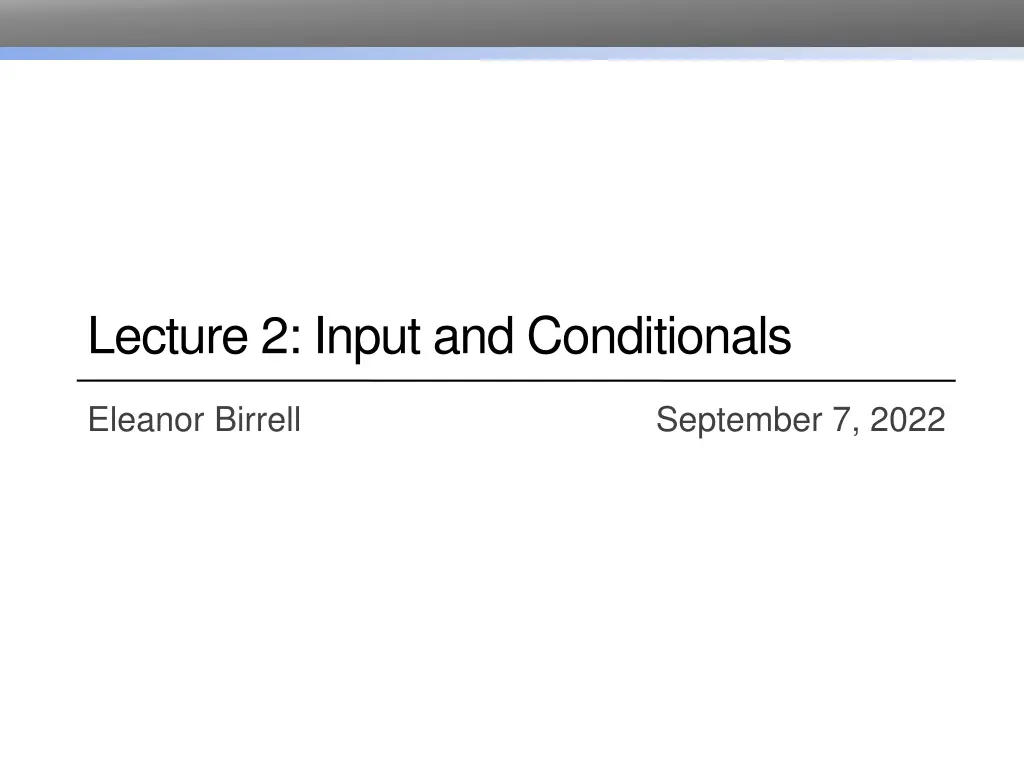
Learning Python: Input, Conditionals, and Functions
Explore the fundamentals of Python programming, including input methods, conditionals, and useful functions. Learn how to modify programs to interact with users, calculate average time per mile, and create interactive exercises. Dive into if statements, boolean data types, and common operators. Enhance your Python skills with practical examples and exercises.
Download Presentation

Please find below an Image/Link to download the presentation.
The content on the website is provided AS IS for your information and personal use only. It may not be sold, licensed, or shared on other websites without obtaining consent from the author. If you encounter any issues during the download, it is possible that the publisher has removed the file from their server.
You are allowed to download the files provided on this website for personal or commercial use, subject to the condition that they are used lawfully. All files are the property of their respective owners.
The content on the website is provided AS IS for your information and personal use only. It may not be sold, licensed, or shared on other websites without obtaining consent from the author.
E N D
Presentation Transcript
Lecture 2: Input and Conditionals Eleanor Birrell September 7, 2022
Review: Values, Types, Operations, Expressions, Variables
Review: Useful (simple) Functions Example Functions type( ) str( ), int( ), float( ) print( ) print(1+2.001) print(1*3) print("1.0"+"2.0") print("Happy"*2 + "?!"*3) print(1*2 + "2"*2) print(type("2")) print(1*2 + int("2")*2) print(str(1)*2 + "2"*2)
Input input() is a function that allows you to get a value from your user
Example How would you change this program so that it asks the user for their time in minutes and seconds and then prints out their average time per mile for the 10K race? miles = 10/1.61 time_mins = 43.5 pace = time_mins/miles print("Your pace is: " + str(pace)) time_hrs = time_mins/60 speed = miles/time_hrs print("Your speed is: " + str(speed))
Exercise Write a program that asks the user for word and a number, then prints the word followed by an exclamation point and a space that many times. For example: Enter a word: happy Enter a positive integer: 3 happy! happy! happy!
What about? what's your favorite positive integer? 13 that's my favorite number too! what a coincidence! what's your favorite positive integer? 20 mine is 13.
if-statements syntax condition if x == 13 : print("that's my favorite number too!") print("what a coincidence!") whitespace matters! condition must be an expression that evaluates to True or False (type bool)
bool datatype - values Values: True and False Operators: and, or, not <bool expression> and <bool expression> True if both expressions True, False otherwise <bool expression> or <bool expression> True if at least one expression True, False otherwise not <bool expression> returns True if expression is False, False otherwise
Boolean Expressions Examples of operations that return a bool: relational operators: ==, !=, >, <, >=, <= 10 < 0 x != 3 11 >= 11 y <= x 11 > 11.0 x = 5 10 == 10.1
Example Assume the variable n currently stores the value 25. What will the following expressions evaluate to? 2 < n and n < 30 n > 2 and < 20 (2 > n) or (n == 25) not (n == n) not (n != 3)
Exercise After executing each snippet of code, the variable val stores a value of type bool. What value does it store? A) val = (5 > 0 and 5 < 10) B) val = (n % 2 == 0 or n % 3 == 0) n = 25 C) s = "string" val = ("String" != s) D) val = not True and False
if-statements syntax condition if x == 13 : print("that's my favorite number too!") print("what a coincidence!") condition must be an expression that evaluates to True or False (type bool) Booleans: True, False relational operators: ==, !=, >, <, >=, <= logical operators: and, or, not functions that evaluate to type bool
if-else statements syntax if x == 13: print("that's my favorite number too!") print("what a coincidence!") else: print("mine is 13")
Exercise s1 = int(input()) if s1 % 4 == 0: print(4*s1) if s1 % 2 == 0: print(2*s1) else: print(s1) What gets printed if the user inputs 2? If they input 3? If they input 4? If they input 5.0?
What about? what's your favorite positive integer? 13 that's my favorite number too! what a coincidence! what's your favorite positive integer? 20 my favorite number is less than that. what's your favorite positive integer? 10 my favorite number is more than that.
Attempt #1: If statements if x == 13: print("that's my favorite number too!") if x > 13: print("my favorite number is less than that.") if x < 13: print("my favorite number is more than that.")
Attempt #2: nested if-statements if x == 13: print("that's my favorite number too!") else: if x > 13: print("my favorite number is less than that.") else: print("my favorite number is more than that.")
Attempt #3: using elif if x == 13: print("that's my favorite number too!") elif x > 13: print("my favorite number is less than that.") else: print("my favorite number is more than that.")
Exercise Convert the following program to a program with the same behavior that doesn't use nested if-statements x = int(input("pos int?\n\t")) if x == 13: print("mine too!") else: if x > 30 or x < 10: print("mine is 13") else: if x == 19: print("19!") else: print("?") print("!")
